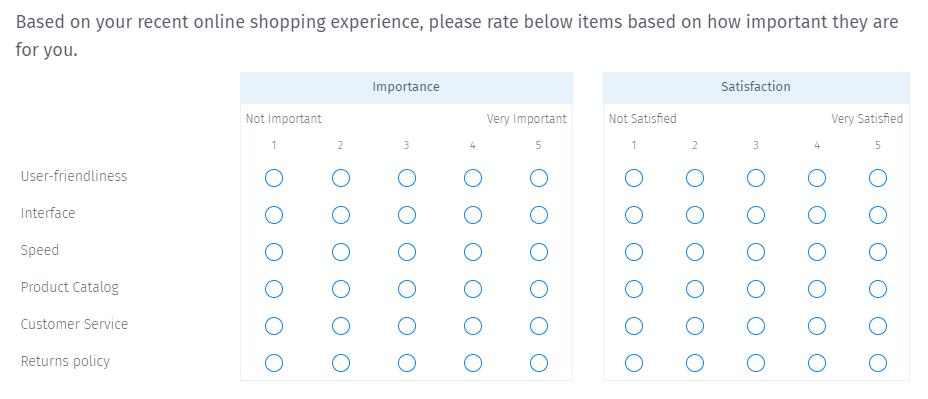For each answer item in rows, a respondent needs to select one of the options in sub-columns. Survey creators can collect responses to cover multiple characteristics or subtopics of a particular topic with ease.
A side by side matrix allows you to let your respondents choose from several variables to obtain the most accurate data. Depending on the situation, this advanced question type is available in the drop-down menu and radio buttons format. Ideally, this question type should be used when there are many interrelated questions with similar answer options. Instead of presenting each correlated topic as a different question, researchers can use a side by side matrix question to show each question in a grid format. Thus, it reduces repetition in the survey questionnaire.
Example of a side by side matrix question
Below is a side by side matrix question example to gather detailed feedback and preferences of website visitors. Based on their answers, the website administrator can take action to design a website such that it caters to the needs of its visitors.
Although a basic multi-point scale matrix or a Likert scale can be used in above scenario, side by side matrix can combine different variables (columns) for the same set parameters (rows). This reduces the length of the survey questionnaire and makes it compact.
Although a basic multi-point scale matrix or a Likert scale can be used in above scenario, side by side matrix can combine different variables (columns) for the same set parameters (rows). This reduces the length of the survey questionnaire and makes it compact.

Another example of side by side matrix application is when product features of different brands need to be compared. Suppose you need to compare what do your respondents prefer between Apple and Dell when it comes to buying a notebook.

Uses of side by side matrix question
This advanced matrix question type can be used in scenarios when you want to collect customers’ feedback and satisfaction. Or when the respondents are required to rank a product on several attributes.
Find out what matters more to the respondents: Side by side matrix can be used to analyze the choices of respondents. There can be times when respondents are not completely satisfied with a particular aspect of your product or service. However, if it isn’t much important for them, then other higher priority items can be worked upon.
Rich data collection: The more responses you collect from the survey takers, the more insights you get into their experiences and opinion. This creates a vast dataset to analyze the data and generate reports.
Gap analysis: The side by side matrix is ideal for conducting integrated gap analysis. For each attribute, it measures the difference between the expectation and delivery and can sort from highest to lowest. It highlights the attributes you need to focus on effectively.
Advantages of side by side matrix question
Gather data for multiple variables at the same time: A side by side matrix question is an advanced survey question type and lets you collect data for multiple variables in the same question.
Concise: Using side by side matrix reduces the length of the survey. It helps avoid repeating the same set of rows in the survey. Hence, the overall design of the survey looks neat and compact. It’s visually rich, conveys more information in one glance, and is easy to compare options for both the survey administrator as well as the respondents.
Easy maintenance: It’s so easy to edit the structure of the question if you need to gather feedback related to another sub-topic. If you need to add a new topic or a qualitative parameter, you just need to add row or column in one question only. With likert scale, the survey creator would have to create a point scale for each topic. Any change in, say, one of the answer items common in all of them, would require changing it at multiple places. Also, creating and removing scales would have been tedious.
Avoid the monotony of similar questions: Interrelated questions can get tedious for the survey creator to analyze and the respondents to answer. Side by side matrix questions combine interlinked questions to eliminate boredom as much as possible. Instead of multiple questions like: “Please rate below features for brand A”, “Please rate below features for brand B”, place different topics as dimensions side by side.
Lesser survey completion time: As the respondents don’t spend much time on reading multiple questions and answers for the same situation, they can complete surveys quickly. Also, it reduces the need to click on the ‘next’ button and thus reduces the chances of a respondent dropping out.
How to use a side by side matrix question in your surveys
Learn how to use this feature and get a better understanding of how it works with our side by side matrix help document.
Survey Software Easy to use and accessible for everyone. Design, send and analyze online surveys.
Research Suite A suite of enterprise-grade research tools for market research professionals.
Customer Experience Experiences change the world. Deliver the best with our CX management software.
Employee Experience Create the best employee experience and act on real-time data from end to end.







